
Exploring the innate connection between human well-being and the natural environment, this post delves into the harmonious blend of biophilic design principles within the sphere of healthcare architecture. As a professional blogger specializing in medicine and health common sense, dietary therapy, and the impact of environments on health, I will dissect how the integration of nature in hospital design is not just an aesthetic choice but a therapeutic tool that can significantly impact patient recovery. We will uncover the transformative power of biophilic elements in healthcare settings and how they can act as a silent healer alongside medical interventions, offering tangible benefits for patients, staff, and family alike.
Table of Contents
The Essence of Biophilia in Healing Spaces
The term ‘biophilia’ is more than just a buzzword in the domain of modern healthcare design; it’s a principle I’ve seen transform sterile medical environments into havens that embrace the innate human connection to nature. The essence of integrating biophilia within healing spaces lies in creating an ambient tug that pulls at the tendrils of our inherent love for life and living systems. In my personal experiences visiting various healthcare facilities, those with elements such as indoor plants, natural light, and views of greenery don’t just appear more aesthetically pleasing, but they resonate on a deeper psychological level, eliciting calmness and an inexplicable sense of hope.
One element of the biophilic design that particularly stands out is the incorporation of living walls or vertical gardens. These lush panels teem with vitality and serve as a visual and olfactory reminder of the world outside, often aiding in patient relaxation. Similarly, the use of natural materials such as wood and stone in interior finishes can subtly reduce stress and anxiety, allowing patients to draw strength from the earthy textures and hues that envelop them.
Another poignant aspect is the strategic deployment of windows to invite a dialogue with the environment. There’s nothing quite like the warm kiss of sunlight breaking through a hospital room to lift spirits and align the body’s natural rhythms. The ebb and flow of natural light not only helps regulate sleep patterns but also underpins a psychological release from the feeling of confinement that hospitalization can bring.
Even the acoustic atmosphere is sprinkled with biophilic elements. The soft murmur of water from a strategically placed indoor fountain, or the gentle rustling of leaves from trees planted within courtyards, provide a sonic backdrop that can shift the focus away from clinical noises and towards the tranquil sounds of nature. And it’s not just anecdotal evidence that reinforces the efficacy of these elements; numerous studies continue to converge on the conclusion that a harmonious blend of natural elements within healthcare settings can significantly improve patient outcomes and hasten recovery.
To deny the impact of a nature-infused environment on the healing process would be to ignore the visceral connection we share with the world around us. As I reflect on the peaceful aura that permeates biophilic-designed spaces, it’s apparent that the subtle interplay between nature and nurture is pivotal in crafting the future of patient-centered healthcare environments where recovery is cultivated, and wellbeing is the cornerstone of design.
Architectural Alchemy: Fusing Nature with Clinical Environments
As I’ve explored the countless facades of hospital structures and peered into the sterile, impersonal rooms typically associated with clinical settings, I’ve experienced firsthand the stark contrast nature’s touch can make. In the pursuit of ‘Architectural Alchemy,’ I’ve seen the transformative power of integrating elements of nature into these environments, a practice that marries form with function and aesthetics with wellness. This sublime fusion is not simply about placing potted plants in corners or hanging landscape paintings on walls; it’s a conscious, purposeful amalgamation of natural elements within the design itself.
Biophilic design in hospitals is akin to stitching a green thread through the very fabric of a building. It can manifest as indoor water features that mimic tranquil streams, offering auditory respite and a connection to the rhythm of nature. I recall the awe in patients’ eyes as they interact with these features, moving from a state of anxiety to one of calm. Another crucial element is the incorporation of natural materials, such as wood and stone, which not only break the monotony of cold, clinical surfaces but also serve as tactile connections to the earth, grounding patients and staff alike.
Furthermore, the innovative use of skylights and strategic window placements can dramatically alter the ambiance of a hospital ward. The subtle dance of shadows and light throughout the day maintains a connection with the outside world’s temporal ebbs and flows, while also aiding the body’s natural circadian rhythms, promoting better sleep and faster recovery. Within this domain, I’ve witnessed the joy of a sunbathed room where patients bask not only in warmth but also in hope.
These architectural decisions go beyond mere aesthetics; they become silent healers, working in concert with medical interventions. By embracing this philosophy, hospitals can transcend traditional barriers and become sanctuaries of healing. The meticulous integration of nature in clinical settings I’ve seen—where corridors turn into pathways of recovery, and rooms become personal retreats—reinforces my belief in biophilia as an essential component of modern healthcare design. Through my journey, I’ve cultivated an appreciation for how spaces that speak the language of nature can potentiate healing in ways that medicine alone cannot.
Patient Rejuvenation through Nature-Infused Hospital Wards
Imagine stepping into a hospital ward that doesn’t intimidate with its sterile coldness but welcomes you with the warmth of nature. Throughout my career, I’ve been a staunch advocate for the healing power of natural elements, and it’s been an enchanting journey to witness their beneficial impact on patients’ recovery processes. Nature-infused hospital wards are not a far-fetched fantasy but a tangible reality in the realm of modern healthcare design.
‘Patient rejuvenation’ isn’t just a buzzword; it’s a transformational experience rooted in evidence-based design. A stay in a hospital ward that’s been kissed by nature’s magic has the power to reduce stress levels and enhance patient well-being. These wards may feature indoor plants that churn out a steady stream of oxygen, harmonizing with softly flowing water features that bring the soothing sounds of nature indoors, creating a soundscape that can calm the most anxious of hearts.
Timber accents and stone textures spread across the walls infuse a rustic charm, embracing patients with a cozy, home-like atmosphere, while large windows reveal expansive views of gardens, trees, or even distant mountains, subtly reinforcing the patient’s connection with the outside world. Furthermore, the integration of circadian lighting systems that mimic natural light patterns can regulate sleep-wake cycles and bolster healing. Each of these thoughtful inclusions serves a purpose beyond aesthetics—rekindling the human-nature bond that modern healthcare environments often overlook.
My visits to such wards have solidified my belief in the restorative prowess of nature. I watched as patients’ eyes lit up at the sight of vibrant greenery, as their muscles relaxed to the rhythm of natural elements. It’s the kind of holistic healing that doesn’t come out of a medicine bottle but flows in through the sunlight or the touch of a cool, leafy plant. Here, technology and nature dance in a delicate balance, creating a humming ecosystem that fosters not just recovery but a renewed zeal for life.
Integrating nature into hospital wards goes beyond creating pleasing visuals—it’s about sculpting a milieu that returns patients to the essence of existence, reminding them through every rock, leaf, and sunbeam that even in the face of illness, the world outside awaits them, full of life and the gentle caress of the earth. In the end, it’s about designing not just for survival, but for wellness; for the kind of rejuvenation that starts with the body but resonates with the spirit.
Catalyzing Recovery: Therapeutic Gardens and Natural Light in Hospitals
Throughout my career as a health and wellness blogger, I’ve explored countless healing environments. Yet, one aspect that consistently captivates me is the transformative power of nature in the healing process. Therapeutic gardens, along with the strategic use of natural light, stand out as pivotal elements in the biophilic design of hospitals. These are more than just aesthetically pleasing spaces; they are vital components that can significantly catalyze patient recovery and enhance overall well-being.
The concept of therapeutic gardens is not new; it has ancient roots and is grounded in the simple truth that connecting with nature is restorative. These gardens are carefully crafted oases within hospital settings, offering a variety of sensory experiences through the inclusion of foliage that changes with the seasons, water features that provide calming sounds, and trails that encourage gentle physical activity. It’s a place where patients and their families can seek respite from the clinical atmosphere, breathe in the fresh air, and let the natural surroundings contribute to their psychological and emotional healing.
Apart from these serene green spaces, the influence of natural light within hospital environments should not be underestimated. Architectural designs that maximize daylight can drastically improve a patient’s mood, sleep pattern, and circadian rhythm. This, in turn, may help reduce recovery times and reliance on pain medications. From personal observations, I’ve noticed how rooms bathed in sunlight tend to lift spirits and cultivate an environment where patients feel more hopeful and positive about their healing journey.
Incorporating these elements of nature into the hospital setting isn’t just a design preference; it’s rooted in evidence-based outcomes. Studies have suggested that patients with a view of nature from their windows may require less pain medication and experience quicker recoveries. As a passionate advocate for wellness, I firmly believe that integrating therapeutic gardens and harnessing natural light is a profound and necessary step towards creating healing spaces that don’t just cure but truly heal.
Biophilic Design Metrics: Assessing the Impact on Health Outcomes
As we delve into the metrics of biophilic design, it is crucial to understand that the impact on health outcomes isn’t just a theoretical concept but a measurable reality. Having worked closely with healthcare professionals and architects, I’ve seen firsthand how incorporating biophilia can nourish the convalescence ecosystem. Therefore, thoroughly evaluating the implications of such design is a step towards substantiating its significance.
One essential metric is the measurement of stress reduction. Biophilic environments, with their serene and therapeutic nature, are posited to lower cortisol levels – the stress hormone. This is often verified by conducting pre- and post-occupancy evaluations that compare cortisol levels in patients before and after the introduction of biophilic elements to the healing space. It’s a tangible indicator that nature isn’t just an aesthetic addition but a profound contributor to wellness.
Another metric is patient recovery time. Statistics on discharge rates and recovery speed provide compelling data on how nature influences healing. Hospitals that have turned to nature-infused wings report a marked improvement in patient recuperation rates. Watching the simple yet profound act of a bloom outside a window or having access to natural light has cut down the recovery period, an outcome that speaks volumes.
Patient and staff satisfaction surveys are the human stories behind the numbers. Questionnaires designed to capture emotional and psychological well-being reflect how patients and healthcare workers feel about the biophilic environment. Their testimonies are a heartfelt endorsement of the soothing and uplifting ambiance that such designs invoke.
Lastly, improvements in cognitive function form part of biophilic design metrics. This encompasses concentration, memory, and emotional stability measures through standardized cognitive tests. For individuals with long-term care needs, these outcomes denote not just recovery but quality of life enhancements.
The intersection of nature and clinical environments is not just a beautiful hypothesis – it’s a practice with verifiable benefits. These metrics, both qualitative and quantitative, are pillars that support the biophilic framework, making it an evidence-based approach to healthcare design – a philosophy I’ve championed in my own work, with outcomes that continue to inspire and heal.
Conclusion
In essence, the principles of biophilic design transcend aesthetic contributions, becoming an integral component of a patient-centric healing journey. We’ve traversed through various aspects of how embracing nature within hospital settings can enhance recovery and elevate the healthcare experience. Harnessing the subtle yet profound effects of natural elements in the design of health facilities holds the promise of not only nurturing the body but also soothing the soul, offering a holistic approach to recovery and well-being.



